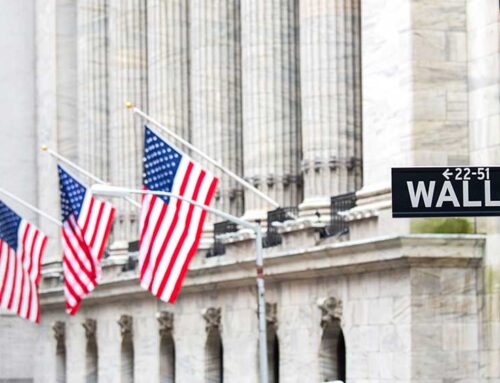Is Bitcoin Trading Like Tech Stocks?
April 16, 2025
For many years after its inception bitcoin was seen as an investment that traded unlike traditional assets, but as it’s tumble in the wake of US President Donald Trump’s tariff announcement, these days it’s trading much like any other risky investment.
Bitcoin fell sharply in the wake of US President Donald Trump’s tariff announcement on April 2, collapsing from $84,600 to $75,000 within a week. That plunge extended declines that began in February. On Jan. 30, bitcoin was worth over $106,000 after a blistering post-election rally.
This drop coincided with a selloff in US stocks, especially technology stocks. During the week following Trump’s announcement on tariffs, bitcoin shed 10.5%, very close to the 11.6% lost by the S&P 500 and 12% by the Nasdaq 100.
“Bitcoin’s heightened correlation with the Nasdaq and S&P 500 reflects its evolving role as a macro-sensitive asset, driven by institutional behavior and policy shifts,” says Adrian Fritz, head of research at 21Shares, a specialized provider of crypto ETPs.
“Institutional investors now treat bitcoin similarly to tech stocks, creating synchronized trading patterns during macroeconomic events. This alignment intensified under Trump’s pro-crypto agenda,” he adds.
“Bitcoin might be decentralized, but it does not trade in a vacuum – when macro fear spikes, it gets hit like everything else,” says WisdomTree’s digital assets research director Dovile Silenskyte.
Trump’s Tariffs and Bitcoin
Trump’s promises to make the United States the new “bitcoin hub” attracted institutional capital, but they also bound bitcoin to political risks impacting traditional markets. Fritz says that over the past quarter, this evolving relationship solidified bitcoin’s status as a risk-on asset.
Thus, when the tariffs sparked a global flight to safety, investors rapidly exited both equities and bitcoin, triggering parallel 15% declines in BTC, the Nasdaq, and the S&P 500 as capital mainly rotated into the much relatively safer haven, like gold.
At the same time, when news broke of a 90-day suspension of the tariffs and suddenly the risk-on sentiment came roaring back, bitcoin surged in line with a rally across equities. On April 9, BTC gained 8.2%, while the S&P 500 rallied 9.5%. “This rebound was not about crypto fundamentals, it was a classic macro-driven relief rally, showing just how plugged-in bitcoin is to the broader market narrative,” says Silenskyte.
For Ferdinando Ametrano, managing director of CheckSig and a professor of Bitcoin and Blockchain Technology at Milan-Bicocca University, “bitcoin is a thermometer of globalization, sensitive to international scenarios. One part of the market likens it to North American tech stocks; another part sees it as digital gold, a safe haven asset.”
Who is right will become clearer in the future, he says, but as of today in the tensest moments the association with equities typical of the most active market participants prevails, because the other component has instead a buy-and-hold approach.
Bitcoin Much Less Volatile Than in The Past
Despite the swings seen in bitcoin recently, some point to data suggesting that the cryptocurrency has become less volatile.
“Over the past five years,” says Silenskyte, “bitcoin’s 90-day annualized volatility has been cut nearly in half – from 95% in March 2021 to 52% in March 2025,” says Silenskyte.
What’s driving this shift?
“Bitcoin has undergone a structural shift toward institutionalisation,” says Silenskyte.
“Bitcoin has entered a phase of accelerated institutionalization, marked by growing participation from professional asset managers and corporate treasuries”, says 21Shares’ Fritz. “This shift is driven by the development of regulated financial instruments such as spot bitcoin ETFs, options contracts, and volatility-linked derivatives, which enable sophisticated strategies like basis trading and risk-hedged exposure.”
Major financial institutions now allocate portions of their portfolios to digital assets. Such institutional footprint has gradually displaced retail-driven speculation, fostering a “market structure with tighter bid-ask spreads and reduced gap risks compared to previous cycles” and concurrently “reduced bitcoin’s historical volatility.”
Max Shannon, research analyst at CoinShares, also highlights the fact that “bitcoin’s status as a 24/7 traded asset means it consistently attracts liquidity, contributing to deeper market structures.” As institutional participation grows and market infrastructure matures, “this increased depth is gradually helping to reduce the asset’s historical volatility,” he says.
What To Expect from Bitcoin Prices Now?
Donald Trump is the first openly pro-crypto US president, and his second term is expected to usher in a friendlier policy environment for crypto markets, but that doesn’t mean it will all be rosy.
“Investors should expect both volatility and opportunity,” says Dovile Silenskyte, who adds that “macro liquidity remains the single most powerful force in markets and bitcoin is no exception.”
Beyond the introduction of favorable regulations for crypto assets in the US, “the opening of the European market, made possible by the bill MiCA, will facilitate the entry of new institutional investors, as we already saw with the launch of ETFs by large institutional players such as BlackRock and Fidelity,” explains Ferdinando Ametrano.
Ametrano thinks that bitcoin can reach “new records in the next 12 to 18 months”, and that “it will consolidate its role in diversified wallets.” But be aware that “price fluctuations will be inevitable.”
The author or authors do own shares in any securities mentioned in this article. Find out about Morningstar’s editorial policies.
Search
RECENT PRESS RELEASES
Related Post




